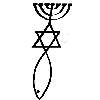The surest confirmation that Christ’s physical return to life is part and parcel of Christianity’s foundation is, as always, the fulfillment of Hebrew prophecy. I had mentioned previously, the annual observation of the Day of Atonement, which is a time of repentance and the hope and assurance of forgiveness. There is no record that I know of about the number of times, if any, the sacrificial sacrifice was rejected by God. The point is, on this day of solemn humility and complete vulnerability to God’s justice, the people had to wait and watch in fear and trembling to see if the atonement was “good enough” for God’s holy standard.
If you haven’t been reading Exodus and Leviticus lately, you might forget the fastidious details in instruction for the priest, his clothing of white linen, cleanliness involving the bathing of his whole body, the animal sacrifice which had to be perfect, without blemish inside or out, the way to touch the animal (on its head), kill, and dispose of its remains, sprinkling and pouring of the blood, how to place the sins of all the people on the head of a second animal, escort it into the wilderness as the scapegoat, “taking away the sins” (not “of the world” YET)… If the priest, his clothing, his adherence to exact instruction as to what to do inside the Tent of Meeting and the Holy of Holies, if the animal was in any way imperfect, if ALL was not acceptable to God, the priest and quite possibly the observing crowd outside would be struck dead. After all, to enter the holiest place meant entering into God’s dwelling. So serious was this that a rope was tied to the High Priest’s ankle, just in case since no one else dare enter therein! He also wore bells on the fringe of his robe for the people to hear when he moved, or not hear, if he didn’t.
Can you imagine the tension when there was a long pause in the priest’s movement? This was not simply a matter of the moment. Physical life and death were not the only concern. If the priest offering the atonement died, even if the people lived to tell, they would be living under the tremendous burden of their guilt, sins unforgiven, for God as they knew Him was fearsome, unapproachable in Righteousness, quick to impugn, chasten and set things aright. The inkling of God’s grace, its foreshadowing, was in the type of Christ who was their High Priest, emerging from the Temple, sacrifice accepted by God, this year’s sins forgiven. Hallelujah! Such joy, we have difficulty understanding, such is our state of casual acceptance, as we live every day under God’s grace. Our plight of ingratitude could very well be worse than Israel’s limited understanding of God’s character. God has been fully revealed to us, with every mercy being shed upon us, only for us to trample them with our next transgression. Gracious God, help us.
Christ came forth, ALIVE from the grave indicating to our fullest measure of understanding, our High Priest’s blood sacrifice was pure and holy, acceptable to God in the spiritual realm.
If you haven’t been reading Exodus and Leviticus lately, you might forget the fastidious details in instruction for the priest, his clothing of white linen, cleanliness involving the bathing of his whole body, the animal sacrifice which had to be perfect, without blemish inside or out, the way to touch the animal (on its head), kill, and dispose of its remains, sprinkling and pouring of the blood, how to place the sins of all the people on the head of a second animal, escort it into the wilderness as the scapegoat, “taking away the sins” (not “of the world” YET)… If the priest, his clothing, his adherence to exact instruction as to what to do inside the Tent of Meeting and the Holy of Holies, if the animal was in any way imperfect, if ALL was not acceptable to God, the priest and quite possibly the observing crowd outside would be struck dead. After all, to enter the holiest place meant entering into God’s dwelling. So serious was this that a rope was tied to the High Priest’s ankle, just in case since no one else dare enter therein! He also wore bells on the fringe of his robe for the people to hear when he moved, or not hear, if he didn’t.
Can you imagine the tension when there was a long pause in the priest’s movement? This was not simply a matter of the moment. Physical life and death were not the only concern. If the priest offering the atonement died, even if the people lived to tell, they would be living under the tremendous burden of their guilt, sins unforgiven, for God as they knew Him was fearsome, unapproachable in Righteousness, quick to impugn, chasten and set things aright. The inkling of God’s grace, its foreshadowing, was in the type of Christ who was their High Priest, emerging from the Temple, sacrifice accepted by God, this year’s sins forgiven. Hallelujah! Such joy, we have difficulty understanding, such is our state of casual acceptance, as we live every day under God’s grace. Our plight of ingratitude could very well be worse than Israel’s limited understanding of God’s character. God has been fully revealed to us, with every mercy being shed upon us, only for us to trample them with our next transgression. Gracious God, help us.
Christ came forth, ALIVE from the grave indicating to our fullest measure of understanding, our High Priest’s blood sacrifice was pure and holy, acceptable to God in the spiritual realm.





